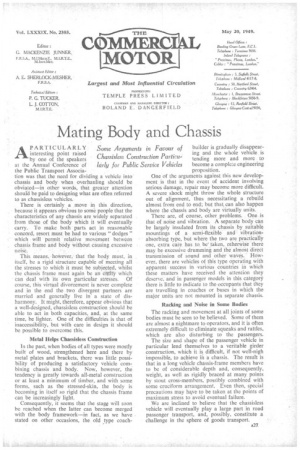Mating Body and Chassis
Page 1

If you've noticed an error in this article please click here to report it so we can fix it.
PARTICULARLY Some Arguments in Favour of interesting point raised by one of the speakers truction
Chassisless Cons
at the Annual Conference of lady for Public Service Vehicles the Public Transport Associa tion was that the need for dividing a vehicle into chassis and body when overhauling should be obviated—in other words, that greater attention should be paid to designing what are often referred to as chassisless vehicles.
There is certainly a move in this direction, because it appears obvious to some people that the characteristics of any chassis are widely separated from those of the body which it will eventually carry. To make both parts act in reasonable concord, resort must be had to various " dodges " which will 'permit relative movement between chassis frame and body without causing _excessive noise.
This means, -hoWever,. that the body must, in itself, be a rigid structure capable of meeting all the stresses to which it must be subjected, whilst the chassis frame must again be an entity which can deal with its own particular stresses. Of course, this virtual divorcement is never complete and in the end the two divergent partners are married and generally live in a state of disharmony. It might, therefore, appear obvious that a well-designed, chassisless construction should be able to act in both capacities, and, at the same time, be lighter. One of the difficulties is that of inaccessibility, but with care in design it should be possible to overcome this.
Metal Helps Chassiskss Construction In the past, when bodies of all types were mostly built of wood, strengthened here and there by metal plates and brackets, there was little possibility of producing a satisfactory vehicle combining chassis and body. Now, however, the tendency is greatly towards all-metal construction or at least a minimum of timber, and with some forms, such as the stressed-skin, the body is becoming in itself so rigid that the chassis frame can be increasingly light.
Consequently, it seems that the stage will soon be reached when the latter can become merged with the body framework—in fact, as we have stated on other occasions, the old ,type coach builder is gradually disappearing and the whole vehicle is tending more and more to become a complete engineering proposition.
One of the arguments against this new development is that in the event of accident involving serious damage, repair may become more difficult. A severe shock might throw the whole structure out of alignment, thus necessitating a rebuild almost from end to end; but that can also happen where the chassis and body are virtually units.
There are, of course, other problems. One is that of noise and vibration. A separate body cart be largely insulated from its chassis by suitable mountings of a semi flexible and vibration absorbing type, but where the two are practically one extra care has to be taken, otherwise there may be excessive drumming and the almost direct transmission of sound and other waves. However, there are vehicles of this type operating with apparent success in various countries in which these matters have received the attention they deserve, and in passenger models in this category there is little to indicate to the occupants that they are travelling in coaches or buses in which the major units are not mounted in separate chassis.
Racking and Noise in Some Bodies The racking and movement at all joints of some bodies must be seen to be believed. Some of them are almost a nightmare to operators, and it is often extremely difficult to eliminate squeaks and rattles, which are also disturbing to the passengers.
The size and shape of the passenger vehicle in particular lend themselves to a veritable girder construction, which it is difficult, if not well-nigh impossible, to achieve in a chassis. The result is that in a long vehicle chassis-frame members have to be of considerable depth and, consequently, weight, as well as rigidly braced at many, points by stout crossImembers, possibly combined with some cruciform arrangement. Even then, special precautions may ha,ve to be taken at the points of maximum stress to avoid eventual failure.
We are inclined to believe that the chassisless vehicle will eventually play a large part in road passenger transport, and, possibly, constitute a challenge in the sphere of goods transport.


























